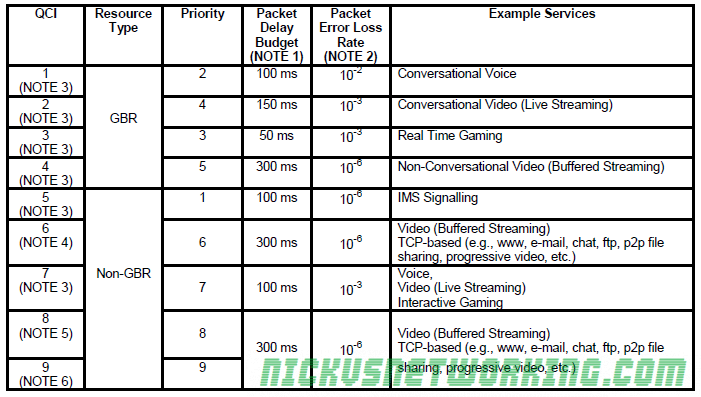The QCI (Quality Class Indicator) is a value of 0-9 to denote the service type and the maximum delays, packet loss and throughput the service requires.

Different data flows have different service requirements, let’s look at some examples:
A VoLTE call requires low latency and low packet loss, without low latency it’ll be impossible to hold a conversation with long delays, and with high packet loss you won’t be able to hear each other.
On the other hand a HTTP (Web) browsing session will be impervious to high latency or packet loss – the only perceived change would be slightly longer page load times as lost packets are resent and added delay on load of a few hundred ms.
So now we understand the different requirements of data flows, let’s look at the columns in the table above so we can understand what they actually signify:
GBR
Guaranteed Bit Rate bearers means our eNB will reserve resource blocks to carry this data no matter what, it’ll have those resource blocks ready to transport this data.
Even if the data’s not flowing a GBR means the resources are reserved even if nothing is going through them.
This means those resource blocks can’t be shared by other users on the network. The Uu interface in the E-UTRAN is shared between UEs in time and frequency, but with GBR bearers parts of this can be reserved exclusively for use by that traffic.
Non-GBR
With a Non-GBR bearer this means there is no guaranteed bit rate, and it’s just best effort.
Non-GBR traffic is scheduled onto resource blocks when they’re not in use by other non-GBR traffic or by GBR traffic.
Priority
The priory value is used for preemption by the PCRF.
The lower the value the more quickly it’ll be processed and scheduled onto the Uu interface.
Packet Delay Budget
Maximum allowable packet delay as measured from P-GW to UE.
Most of the budget relates to the over-the-air scheduling delays.
The eNB uses the QCI information to make its scheduling decisions and packet prioritisation to ensure that the QoS requirements are met on a per-EPS-bearer basis.
(20ms is typically subtracted from this value to account for the radio propagation delay on the Uu interface)
Packet Error Loss Rate (PELR)
This is packets lost on the Uu interface, that have been sent but not confirmed received.
The PELR is an upper boundary for how high this can go, based on the SDUs (IP Packets) that have been processed by the sender on RLC but not delivered up to the next layers (PDCP) by the receiver.
(Any traffic bursting above the GBR is not counted toward the PELR)
(The list is now larger than 0-9 with 3GPP adding extra QCI values for MCPTT, V2X, etc, the full list is available here in table 6.1.7A)